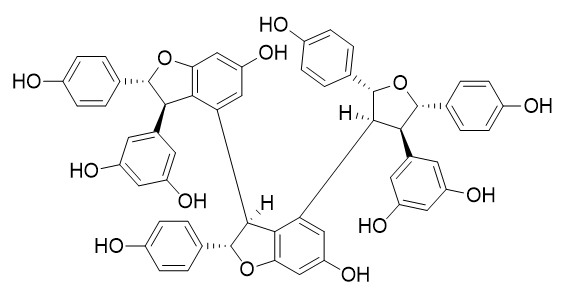Carasinol B
Carasinol B is a natural product from Carex humilis Leyss.
Inquire / Order:
manager@chemfaces.com
Technical Inquiries:
service@chemfaces.com
Tel:
+86-27-84237783
Fax:
+86-27-84254680
Address:
1 Building, No. 83, CheCheng Rd., Wuhan Economic and Technological Development Zone, Wuhan, Hubei 430056, PRC
Providing storage is as stated on the product vial and the vial is kept tightly sealed, the product can be stored for up to
24 months(2-8C).
Wherever possible, you should prepare and use solutions on the same day. However, if you need to make up stock solutions in advance, we recommend that you store the solution as aliquots in tightly sealed vials at -20C. Generally, these will be useable for up to two weeks. Before use, and prior to opening the vial we recommend that you allow your product to equilibrate to room temperature for at least 1 hour.
Need more advice on solubility, usage and handling? Please email to: service@chemfaces.com
The packaging of the product may have turned upside down during transportation, resulting in the natural compounds adhering to the neck or cap of the vial. take the vial out of its packaging and gently shake to let the compounds fall to the bottom of the vial. for liquid products, centrifuge at 200-500 RPM to gather the liquid at the bottom of the vial. try to avoid loss or contamination during handling.
Biomol Ther (Seoul).2024, 32(2):214-223.
J Chromatogr B Analyt Technol Biomed Life Sci.2021, 1187:123012.
Tissue Cell.2024, 88:102401.
Nutrients2023, 15(18), 4016.
Bio-protocol2018, 9(14):e3301
Saudi Pharm J2020, 10.1016
Biomed Pharmacother.2024, 179:117395.
Front Microbiol.2020, 11:583594.
Asian Journal of Chemistry2018, 30(12):2699-2703
Food Funct.2022, D1FO03838A.
Related and Featured Products
Biol Pharm Bull. 2006 Apr;29(4):608-12.
Simultaneous determination of the contents of three stilbene oligomers in Caragana sinica collected in different seasons using an improved HPLC method.[Pubmed:
16595888]
METHODS AND RESULTS:
The objectives of this research were to determine simultaneously the contents of two stilbene tetramers, Carasinol B (1) and kobophenol A (2), and one stilbene trimer, (+)-alpha-viniferin (3), in the roots, tubers, and leaves of Caragana sinica in various seasons. A HPLC method has been developed for efficiently quantifying the three analytes in the plant. Using this method, different samples of Caragana sinica were evaluated.
CONCLUSIONS:
The results showed that the contents of 1, 2, and 3 in the roots were much higher than those in the tubers, and the contents of stilbene tetramers were maximal in winter while the contents of the stilbene trimer were maximal in summer. Compounds 1, 2, and 3 could not be detected in the flowers of Caragana sinica in our detection ranges.



